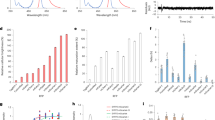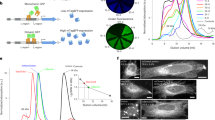Abstract
Based on the mechanism for chromophore formation in red fluorescent proteins, we developed three mCherry-derived monomeric variants, called fluorescent timers (FTs), that change their fluorescence from the blue to red over time. These variants exhibit distinctive fast, medium and slow blue-to-red chromophore maturation rates that depend on the temperature. At 37 °C, the maxima of the blue fluorescence are observed at 0.25, 1.2 and 9.8 h for the purified fast-FT, medium-FT and slow-FT, respectively. The half-maxima of the red fluorescence are reached at 7.1, 3.9 and 28 h, respectively. The FTs show similar timing behavior in bacteria, insect and mammalian cells. Medium-FT allowed for tracking of the intracellular dynamics of the lysosome-associated membrane protein type 2A (LAMP-2A) and determination of its age in the targeted compartments. The results indicate that LAMP-2A transport through the plasma membrane and early or recycling endosomes to lysosomes is a major pathway for LAMP-2A trafficking.
This is a preview of subscription content, access via your institution
Access options
Subscribe to this journal
Receive 12 print issues and online access
$259.00 per year
only $21.58 per issue
Buy this article
- Purchase on Springer Link
- Instant access to full article PDF
Prices may be subject to local taxes which are calculated during checkout




Similar content being viewed by others
References
Shaner, N.C., Patterson, G.H. & Davidson, M.W. Advances in fluorescent protein technology. J. Cell Sci. 120, 4247–4260 (2007).
Miyawaki, A. & Karasawa, S. Memorizing spatiotemporal patterns. Nat. Chem. Biol. 3, 598–601 (2007).
Terskikh, A. et al. “Fluorescent timer”: protein that changes color with time. Science 290, 1585–1588 (2000).
Mirabella, R., Franken, C., van der Krogt, G.N., Bisseling, T. & Geurts, R. Use of the fluorescent timer DsRed-E5 as reporter to monitor dynamics of gene activity in plants. Plant Physiol. 135, 1879–1887 (2004).
Duncan, R.R. et al. Functional and spatial segregation of secretory vesicle pools according to vesicle age. Nature 422, 176–180 (2003).
Verkhusha, V.V., Chudakov, D.M., Gurskaya, N.G., Lukyanov, S. & Lukyanov, K.A. Common pathway for the red chromophore formation in fluorescent proteins and chromoproteins. Chem. Biol. 11, 845–854 (2004).
Shaner, N.C. et al. Improved monomeric red, orange and yellow fluorescent proteins derived from Discosoma sp. red fluorescent protein. Nat. Biotechnol. 22, 1567–1572 (2004).
Eskelinen, E. et al. Role of LAMP-2 in lysosome biogenesis and autophagy. Mol. Biol. Cell 13, 3355–3368 (2002).
Cuervo, A.M. & Dice, J.F. A receptor for the selective uptake and degradation of proteins by lysosomes. Science 273, 501–503 (1996).
Bonifacino, J.S. & Traub, L.M. Signals for sorting of transmembrane proteins to endosomes and lysosomes. Annu. Rev. Biochem. 72, 395–447 (2003).
Storrie, B. & Desjardins, M. The biogenesis of lysosomes: is it a kiss and run, continuous fusion and fission process? Bioessays 18, 895–903 (1996).
Shu, X., Shaner, N.C., Yarbrough, C.A., Tsien, R.Y. & Remington, S.J. Novel chromophores and buried charges control color in mFruits. Biochemistry 45, 9639–9647 (2006).
Bevis, B.J. & Glick, B.S. Rapidly maturing variants of the Discosoma red fluorescent protein (DsRed). Nat. Biotechnol. 20, 83–87 (2002).
Remington, S.J. Fluorescent proteins: maturation, photochemistry and photophysics. Curr. Opin. Struct. Biol. 16, 714–721 (2006).
Strongin, D.E. et al. Structural rearrangements near the chromophore influence the maturation speed and brightness of DsRed variants. Protein Eng. Des. Sel. 20, 525–534 (2007).
Yarbrough, D., Wachter, R.M., Kallio, K., Matz, M.V. & Remington, S.J. Refined crystal structure of DsRed, a red fluorescent protein from coral, at 2.0-A resolution. Proc. Natl. Acad. Sci. USA 98, 462–467 (2001).
Reid, B.G. & Flynn, G.C. Chromophore formation in green fluorescent protein. Biochemistry 36, 6786–6791 (1997).
Zimmer, M. Green fluorescent protein (GFP): applications, structure, and related photophysical behavior. Chem. Rev. 102, 759–781 (2002).
Bunch, T.A., Grinblat, Y. & Goldstein, L.S. Characterization and use of the Drosophila metallothionein promoter in cultured Drosophila melanogaster cells. Nucleic Acids Res. 16, 1043–1061 (1988).
Gossen, M. & Bujard, H. Tight control of gene expression in mammalian cells by tetracycline-responsive promoters. Proc. Natl. Acad. Sci. USA 89, 5547–5551 (1992).
Verkhusha, V.V. et al. High stability of Discosoma DsRed as compared to Aequorea EGFP. Biochemistry 42, 7879–7884 (2003).
Harter, C. & Mellman, I. Transport of the lysosomal membrane glycoprotein lgp120 (lgp-A) to lysosomes does not require appearance on the plasma membrane. J. Cell Biol. 117, 311–325 (1992).
Hunziker, W. & Geuze, H.J. Intracellular trafficking of lysosomal membrane proteins. Bioessays 18, 379–389 (1996).
Carlsson, S.R. & Fukuda, M. The lysosomal membrane glycoprotein lamp-1 is transported to lysosomes by two alternative pathways. Arch. Biochem. Biophys. 296, 630–639 (1992).
Mathews, P.M., Martinie, J.B. & Fambrough, D.M. The pathway and targeting signal for delivery of the integral membrane glycoprotein LEP100 to lysosomes. J. Cell Biol. 118, 1027–1040 (1992).
Akasaki, K., Michihara, A., Mibuka, K., Fujiwara, Y. & Tsuji, H. Biosynthetic transport of a major lysosomal membrane glycoprotein, lamp-1: convergence of biosynthetic and endocytic pathways occurs at three distinctive points. Exp. Cell Res. 220, 464–473 (1995).
Gough, N.R. & Fambrough, D.M. Different steady state subcellular distributions of the three splice variants of lysosome-associated membrane protein LAMP-2 are determined largely by the COOH-terminal amino acid residue. J. Cell Biol. 137, 1161–1169 (1997).
Shaper, N.L. et al. Bovine galactosyltransferase: identification of a clone by direct immunological screening of a cDNA expression library. Proc. Natl. Acad. Sci. USA 83, 1573–1577 (1986).
Narimatsu, H., Sinha, S., Brew, K., Okayama, H. & Qasba, P.K. Cloning and sequencing of cDNA of bovine N-acetylglucosamine (beta 1–4)galactosyltransferase. Proc. Natl. Acad. Sci. USA 83, 4720–4724 (1986).
Qasba, P.K., Ramakrishnan, B. & Boeggeman, E. Structure and function of beta -1,4-galactosyltransferase. Curr. Drug Targets 9, 292–309 (2008).
Strous, G.J. Golgi and secreted galactosyltransferase. CRC Crit. Rev. Biochem. 21, 119–151 (1986).
Teasdale, R.D., D'Agostaro, G. & Gleeson, P.A. The signal for Golgi retention of bovine beta 1,4-galactosyltransferase is in the transmembrane domain. J. Biol. Chem. 267, 4084–4096 (1992).
Baird, G.S., Zacharias, D.A. & Tsien, R.Y. Biochemistry, mutagenesis, and oligomerization of DsRed, a red fluorescent protein from coral. Proc. Natl. Acad. Sci. USA 97, 11984–11989 (2000).
Ho, S.N., Hunt, H.D., Horton, R.M., Pullen, J.K. & Pease, L.R. Site-directed mutagenesis by overlap extension using the polymerase chain reaction. Gene 77, 51–59 (1989).
Chudakov, D.M. et al. Photoswitchable cyan fluorescent protein for protein tracking. Nat. Biotechnol. 22, 1435–1439 (2004).
Niwa, H. et al. Chemical nature of the light emitter of the Aequorea green fluorescent protein. Proc. Natl. Acad. Sci. USA 93, 13617–13622 (1996).
Patterson, G.H., Knobel, S.M., Sharif, W.D., Kain, S.R. & Piston, D.W. Use of the green fluorescent protein and its mutants in quantitative fluorescence microscopy. Biophys. J. 73, 2782–2790 (1997).
Shaner, N.C., Steinbach, P.A. & Tsien, R.Y. A guide to choosing fluorescent proteins. Nat. Methods 2, 905–909 (2005).
Mendes, P. Biochemistry by numbers: simulation of biochemical pathways with Gepasi. Trends Biochem. Sci. 22, 361–363 (1997).
Acknowledgements
We thank J. Zhang (Albert Einstein College of Medicine) for assistance with flow cytometry. We are grateful to R. Tsien (University of California at San Diego) for the complementary DNA of mCherry and D.Reeves (Albert Einstein College of Medicine) for the pcDNA-3.1-LAMP-2A-TSapphire-GFP vector. This work was supported by grants from the US National Institutes of Health (GM070358 and GM073913 to V.V.V. and AG021904 to A.M.C.).
Author information
Authors and Affiliations
Contributions
F.V.S. and I.S.G. developed the proteins. F.V.S., K.S.M. and K.D.P. characterized the proteins in vitro. O.M.S. and F.V.S. characterized the proteins in mammalian cells. V.V.V. designed and planned the project and, together with A.M.C., F.V.S. and O.M.S., wrote the manuscript.
Corresponding author
Supplementary information
Supplementary Text and Figures
Supplementary Figures 1–7, Supplementary Tables 1 and 2, and Supplementary Methods (PDF 400 kb)
Rights and permissions
About this article
Cite this article
Subach, F., Subach, O., Gundorov, I. et al. Monomeric fluorescent timers that change color from blue to red report on cellular trafficking. Nat Chem Biol 5, 118–126 (2009). https://doi.org/10.1038/nchembio.138
Received:
Accepted:
Published:
Issue Date:
DOI: https://doi.org/10.1038/nchembio.138
This article is cited by
-
Ghrelin rapidly elevates protein synthesis in vitro by employing the rpS6K-eEF2K-eEF2 signalling axis
Cellular and Molecular Life Sciences (2022)
-
Intracellular arginine-dependent translation sensor reveals the dynamics of arginine starvation response and resistance in ASS1-negative cells
Cancer & Metabolism (2021)
-
BW5147 and Derivatives for the Study of T Cells and their Antigen Receptors
Archivum Immunologiae et Therapiae Experimentalis (2020)
-
Deciphering CD4+ T cell specificity using novel MHC–TCR chimeric receptors
Nature Immunology (2019)
-
A modular degron library for synthetic circuits in mammalian cells
Nature Communications (2019)



